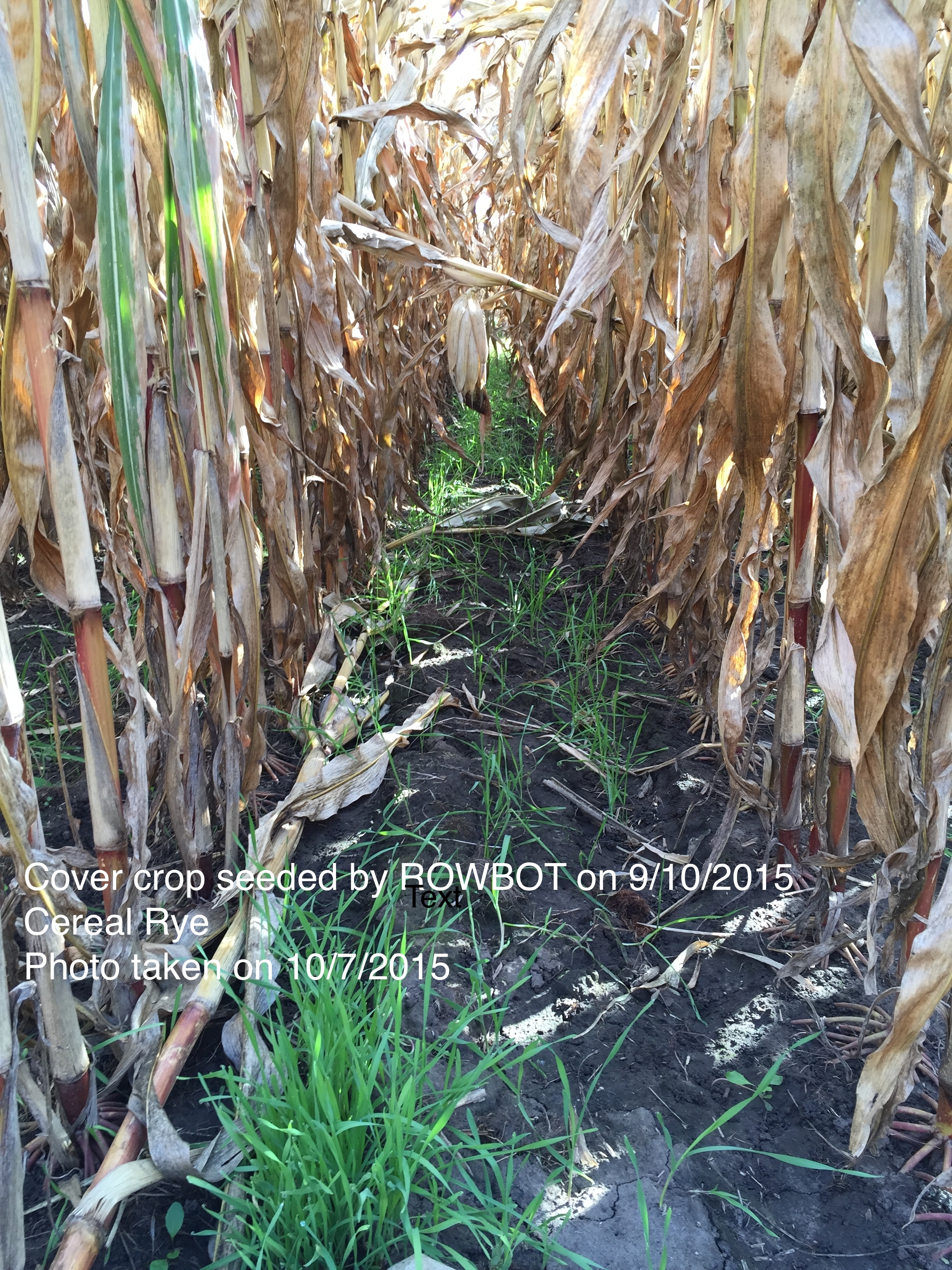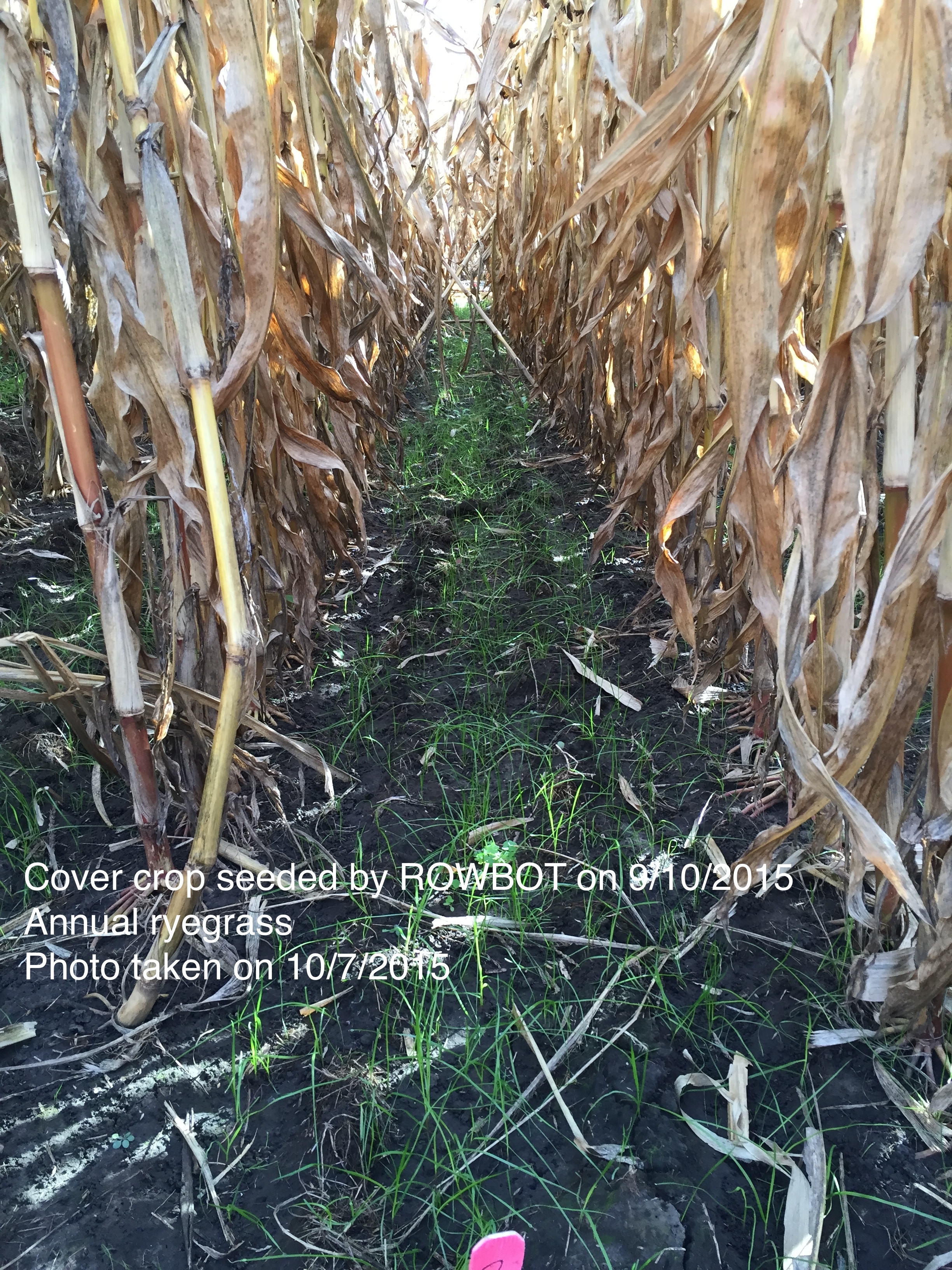Report from our cover crop plots
We recently began a collaboration with Prof. Scott Wells at the University of Minnesota to test the effect of seeding date on cover crop emergence. Here are some photos taken today from the plots at the U of MN's field station in Rosemount. The seeding date was September 10th, so the photos are a month after seeding. While we did have some helpful rains, our good emergence underscores the benefit of seeding down low via ROWBOT. This is a preliminary trial that included cereal rye, annual ryegrass, and red clover. Our prototype robotic platform handled the plot environment very well, and we expect to conduct more plot trials next season.
(NOTE: click on the photo to cycle through three images.)
Spring: Rowbot-seeded Cover Crops Looking Good
Strips of cover crop seeded by Rowbot in 2014 are looking pretty green this spring, even as compared to the aerial seeding in the rest of this field in Illinois.
Many thanks to Elliot Lagacy at the Illinois Department of Agriculture for sharing this picture of a demonstration strip interseeded by Rowbot:
Strips of cover crops interseeded by Rowbot in 2014 are looking lush in 2015. (Photo: Elliot Lagacy, Illinois Department of Ag.)
The thick green strips were interseeded by Rowbot in August 2014, while the rest of the field was seeded aerially. This is just one field and one year, but the results sure are exciting.
Our thanks go out to grower Dale Stierwalt as well as the NRCS, Department of Ag., and the Champaign County SWCD for setting up this field and giving others a glimpse of what's next on the farm.
Rowbot featured in the Guardian as example of state-of-the-art farming
We're excited to have been featured in an article published today by the Guardian on the rapidly growing ag tech field that describes how "Rowbot is at the forefront of a new trend: entrepreneurs creating high-tech applications for agriculture." The video below is a great example of how we are pushing the limits of technology. This robotic platform has now driven over 50 miles in self-driving mode.
Rowbot featured in Corn+Soybean Digest
Many thanks to some of the early Rowbot customers and ag retailers who were willing to be interviewed about their results for this Corn+Soybean Digest article. These growers and ag retailers are at the forefront of imagining how new, robotic equipment can change what's possible on their fields. We really appreciate their support as well as the coverage from the magazine. Grower and agronomist feedback will remain critical as we develop more and better robotic services for the world's most important crops.
Hundreds attend Rowbot demos in Corn Belt
Hundreds of people attended Rowbot demos late this summer in conjunction with Rowbot's test-marketing of the first commercial, robotic services for the king crop.
In Illinois, a Rowbot prototype was used to demonstrate interseeding of cover crops into corn in collaboration with Growmark, the Illinois Council on Best Management Practices, the Conservation Technology Innovation Center, and the Illinois Department of Agriculture.
In Minnesota, interseeding of cover crops was shown in conjunction with national ag retailer Crop Production Services. As well, a Rowbot prototype was shown at select Field Days in Rowbot test markets in Minnesota, including an Early Harvest Day at a field that Rowbot had side-dressed in July.
Growers get first look at the Rowbot prototype on a field it had side-dressed earlier in the season (Photo: Randy Michelson, CPS MN-SD)
We thought we'd share three of the most common Field Day questions and our answers:
"You mean it actually steers by seeing the corn?" Yup.
"If you want to get more acreage done faster, you just deploy more Rowbots?" Yup.
"What other work will Rowbots be able to do?" Stay tuned.
Rowbot featured in MIT's Technology Review
We are excited to have caught the attention of editors at Technology Review. They just published a piece by Dave Talbot highlighting our recent milestones as farmers begin to hire Rowbots to improve in-season management of corn. Here's a link to the article.
Rowbot in the field
During July and August, the Rowbot was at work for a number of farmers in Minnesota and Illinois. Quite a few farmers and others in the ag sector stopped by to have a look at what's next on the farm.
In test-marketing fields for paying customers through our channel partners, Rowbot applied nitrogen fertilizer in Minnesota during the prime in-season nitrogen window. This year, this new, height un-constrained feeding of the corn was especially welcome given the high N losses after heavy spring rains. Although every year won't be this wet, many corn farmers commented how this year highlighted the cost, yield, and stewardship benefits of spoon-feeding corn - using Rowbots!
Rowbot also demonstrated cover crop seeding into tall corn during August, both in Illinois and Minnesota. Farmers, agronomists, and soil scientists eager for cover crop inter-seeding that makes sense gave the Rowbot (and us!) a warm welcome. The photo below is our prototype configured for cover crop seeding, as well as a picture of cover crop germination on a field four days after Rowbot seeded it with a grower-selected mix.
Photo credits: Dean Thomas
Precision agriculture becomes mainstream in Minnesota
Rowbot is highlighted in a recent piece on precision agriculture in the Minneapolis - St. Paul Star Tribune. Precision ag approaches help farmers tailor their management to address differences in soil type and other factors across a field, rather than treating fields—or entire farms—as uniform blocks. With our small, automatic platform, we intend to take precision ag to new heights, pushing this tailored treatment toward the plant level.
Rowbot is mission critical
Rowbot is featured on the cover of this month's issue of Mission Critical, a publication of The Association for Unmanned Vehicle Systems International (AUVSI), the world's largest non-profit organization devoted exclusively to advancing the unmanned systems and robotics community. The piece highlights how ground robotic vehicles will play a big role in the ag robotics market that is expected to grow from $817 million in 2013 to over $16 billion by 2020.
Later planting and fertilizer supplies increases need for in-season N management
Much of the 2013 U.S. corn crop was planted rapidly, even if not at a record-setting pace. Not only was planting compressed into a narrow window beyond most grower's comfort zone, but field conditions prevented some growers from applying fertilizer at or right before planting. This scenario puts pressure on growers to augment their crop's nitrogen (N) needs during the season, after the time-sensitive operation of planting is finished.
It is looking like the 2014 planting season is going to be a repeat for much of the Corn Belt, thanks to the combination of a long, hard winter and plenty of rain this spring.
A recent post on Ag Professional discusses the added complication of potentially low N supplies due to barge and rail delays. Specifically, this piece highlights the fact that corn requires very little N early on, so applying N after planting is a good solution to logistical challenges around planting time.
Thus, not only can in-season N applications (sidedressing) help solve logistical challenges at planting, it plays right into the 4Rs (right source, right rate, right place, and right timing) of nutrient stewardship promoted by the International Plant Nutrition Institute (IPNI) and others.


















